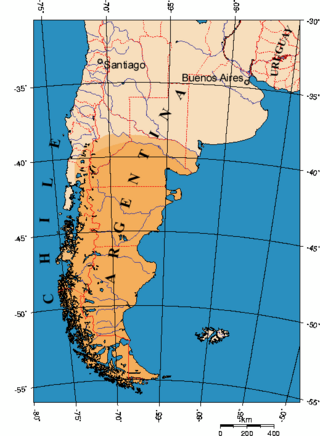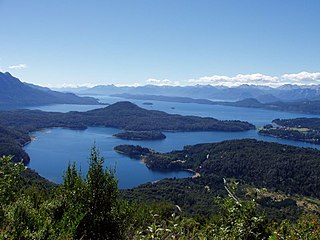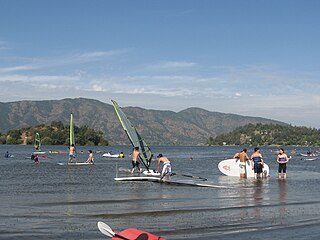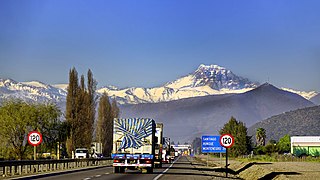Related Research Articles

Sir Francis Drake was an English explorer and privateer best known for his circumnavigation of the world in a single expedition between 1577 and 1580. This was the first English circumnavigation, and third circumnavigation overall. He is also known for participating in the early English slaving voyages of his cousin, Sir John Hawkins, and John Lovell. Having started as a simple seaman, in 1588 he was part of the fight against the Spanish Armada as a vice-admiral.

Patagonia is a geographical region that encompasses the southern end of South America, governed by Argentina and Chile. The region comprises the southern section of the Andes Mountains with lakes, fjords, temperate rainforests, and glaciers in the west and deserts, tablelands and steppes to the east. Patagonia is bounded by the Pacific Ocean on the west, the Atlantic Ocean to the east, and many bodies of water that connect them, such as the Strait of Magellan, the Beagle Channel, and the Drake Passage to the south.

The Magallanes Region, officially the Magallanes y la Antártica Chilena Region, is one of Chile's 16 first order administrative divisions. It is the southernmost, largest, and second least populated region of Chile. It comprises four provinces: Última Esperanza, Magallanes, Tierra del Fuego, and Antártica Chilena.

Neuquén is a province of Argentina, located in the west of the country, at the northern end of Patagonia. It borders Mendoza Province to the north, Rio Negro Province to the southeast, and Chile to the west. It also meets La Pampa Province at its northeast corner.

Licancabur is a stratovolcano on the border between Bolivia and Chile, south of the Sairecabur volcano and west of Juriques. Part of the Andean Central Volcanic Zone, it has a prominent, 5,916-metre (19,409 ft)-high cone. A 400-metre (1,300 ft) summit crater containing Licancabur Lake, a crater lake which is among the highest lakes in the world, caps the volcano. Three stages of lava flows emanate from the edifice.

The Transandine Railway was a 1,000 mmmetre gauge combined rack and adhesion railway which operated from Mendoza in Argentina, across the Andes mountain range via the Uspallata Pass, to Santa Rosa de Los Andes in Chile, a distance of 248 km.

The Alicanto is a mythological nocturnal bird of the desert of Atacama, pertaining to Chilean mythology. Legend says that the alicanto's wings shine at night with beautiful, metallic colors, and their eyes emit strange lights. The color of the wings may indicate the type of ore it eats, golden if from a gold mine and silvery if from a silver mine. Some descriptions also portray the color of the wings as copper-green.

Crinodendron patagua, the patagua or lily of the valley tree, is an evergreen tree that grows in Chile from 33° to 36° South latitude, up to 1200 m (4000 ft) above sea level in elevation. It lives in wet places and prefers ravines. An endangered associate tree is the Chilean wine palm, Jubaea chilensis, whose distribution was much wider prehistorically. This tree reaches a height up to 10 m (33 ft).

The Pincheira brothers was an infamous royalist outlaw group in Chile and Argentina active from 1818 to 1832. The gang fought initially in the Chilean War of Independence as royalist guerrillas during the Guerra a muerte phase. After Vicente Benavides was executed and the royalist resistance collapsed, they became armed bandits who sought to live outside the new states of Chile and Argentina. Later they specialized in cattle raiding and robbery. The Pincheira brothers formed an alliance with the Boroanos tribe that had settled in Salinas Grandes and Sierra de la Ventana and attacked with them Carmen de Patagones and Fortaleza Protectora Argentina. As such they were a multiethnic group.
February 10, 1827: Señor Coronel Buchefe. De lo que prebiene del indulto no podemos porque no somos solos que peliamos pues ustedes saben que el portugues aliado se halla peliando en Buenos ayres i si ustedes gustan invernar invernen que no les hace ningun perjuicio. Bien bedo yo del que no tengo fuerzas para contra Restar con ustedes i aci si V. Me busca si me esta a cuenta atacare i de no me andare por los campos. José Antonio Pincheira.
Hiking in Chile is characterized by a wide range of environments and climates for hikers, which largely results from Chile's unusual, ribbon-like shape, which is 4,300 kilometres long and on average 175 kilometres wide. These range from the world's driest desert, the Atacama, in the north, through a Mediterranean climate in the center, to the glaciers, fjords and lakes of Patagonia in the south.

Between 1830 and 1850, Chilean silver mining grew at an unprecedented pace which transformed mining into one of the country's principal sources of wealth. The rush caused rapid demographic, infrastructural, and economic expansion in the semi-arid Norte Chico mountains where the silver deposits lay. A number of Chileans made large fortunes in the rush and made investments in other areas of the economy of Chile. By the 1850s, the rush was in decline and lucrative silver mining definitively ended in the 1870s. At the same time, mining activity in Chile reoriented to saltpetre operations.

Farellones is a village and ski resort located 36 km from Santiago, Chile. It was founded during the 1930s, nestled in a small valley in the Andes mountains close to other ski areas such as Valle Nevado, La Parva and El Colorado.

The Mission of Nahuel Huapi was an intermittent Jesuit mission that existed in colonial times on the shores of Nahuel Huapi Lake, northern Patagonia. The exact locations of the missions are not known but it has been suggested, based on a Christian grave finding, that the mission of the early 18th century was located in Huemul Peninsula.

Sairecabur is a volcano located on the frontier between Bolivia and Chile. It is part of the Andean Central Volcanic Zone. Sairecabur proper is 5,971 m (19,590 ft) high; other mountains in the range are 5,722 m (18,773 ft) high Curiquinca, 5,819 m (19,091 ft) high Escalante and 5,748 m (18,858 ft) high Cerro Colorado, all of which have erupted a number of lava flows. Also in close proximity to Sairecabur lie the volcanic centres Licancabur, Putana and Juriques.

Laguna de Aculeo is since 2018 a dried-out lake located in the city of Paine, Maipo Province, Santiago Metropolitan Region, Chile. It featured muddy banks and is surrounded by gently tilting ground. The lake's bottom is largely impermeable limiting its connection to underground aquifers. It classifies as a sediment-dammed lake.
Cueva del Pirata, Spanish for "Cave of the Pirate" is a sea cave in the town of Quintero, near Valparaíso, Chile.
Cueva de los Pincheira is rock shelter located about 65 kilometres (40 mi) southeast of Chillán, in Ñuble Region, Central Chile. The rock shelter is famous for being a hideout of the Pincheira brothers, a royalist outlaw gang. During high season there are reenactments in the cave.
Carbuncle is a legendary species of small animal in South American folklore, specifically in the mining folklore of northern Chile. The animal is said to contain riches of some sort; in some versions it is a precious stone that gives fortune and good luck to its owner.

Ocoa is a valley and locality located in commune of Hijuelas in the interior of Valparaíso Region, Chile. Historically Ocoa was the site of a large landholding owned by the Jesuits. There the Jesuits grep hemp. It was confiscated during the Suppression of the Society of Jesus in 1767. Folklore says Jesuits buried their valuables. By some accounts the buried treasure was once found but nothing was extracted since the vault proved resistant to dynamite. Another saying tells that those who seek to recover the treasure become cursed.

Laguna de los Cristales is a small lake located in the Andes of O'Higgins Region in Central Chile. The lake is natural in origin, but its water level was raised by a dam inaugurated in 1976 aimed to provide water for irrigation in Rengo. Local folklore tells of a treasure, an entierro, that is hidden in the bottom of the lake.
References
- 1 2 3 4 Montencino 2015, p. 268–273
- ↑ Vicuña Cifuentes, Julio (1915). Mitos y supersticiones recogidos de la tradición oral chilena (in Spanish). Santiago de Chile: Imprenta Universitaria. pp. 1–2.
- ↑ Plath 1979, p. 133.
- ↑ Montencino 2015, p. 196-197
- ↑ Plath 1979, p. 127.
- 1 2 Plath 1979, p. 129
- 1 2 3 4 Plath 1979, p. 129.
- 1 2 Plath 1979, p. 128.
- Bibliography
- Montecino Aguirre, Sonia (2015). Mitos de Chile: Enciclopedia de seres, apariciones y encantos (in Spanish). Catalonia. ISBN 978-956-324-375-8.
- Plath, Oreste (1979). Folklore chileno (in Spanish). Santiago, Chile: Editorial Nascimiento.
